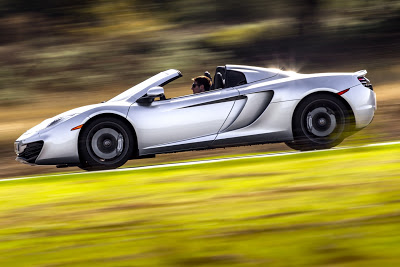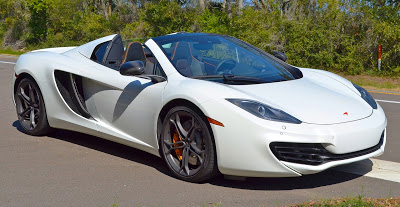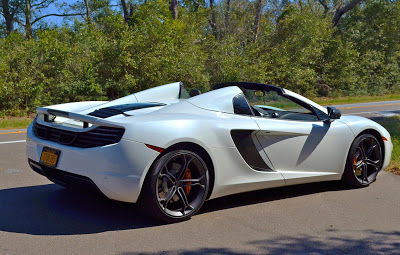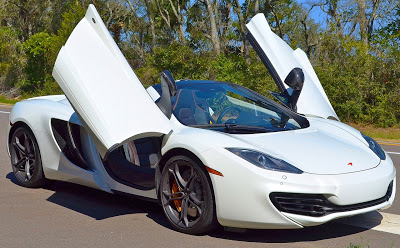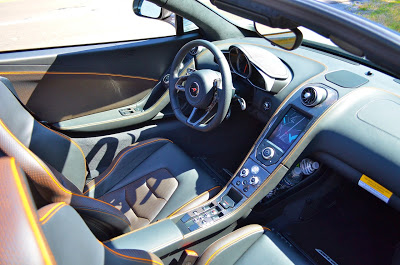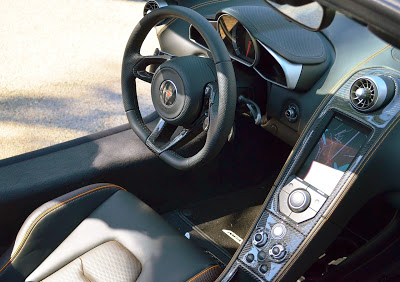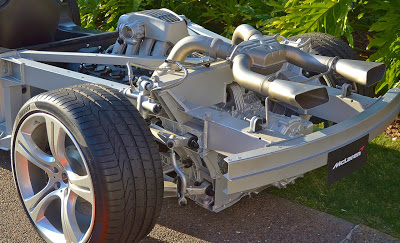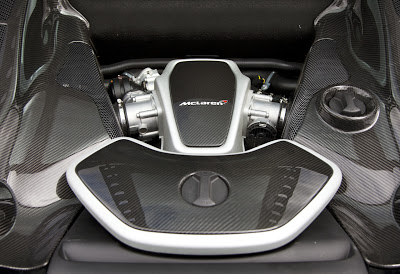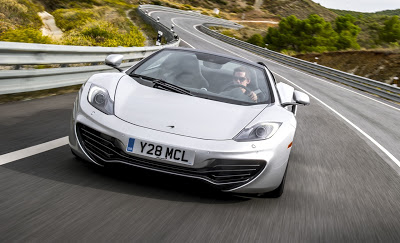And, he wants one!
Sure, there were the few hundred ASC/McLaren Ford Mustangs in the 1980s, as well as ASC/McLaren supported ‘87 Buick GNX screamers, 547 to be exact. Then in 1991, the company used its carbon fiber technology to build the F1, a three-seat, 627-horsepower street-legal Supercar. And in 2003, the $465,650 Mercedes-Benz SLR (McLaren) came
with a carbon fiber body and platform and a supercharged 5.4-liter AMG Mercedes V-8.
Its 628 thundering horses propelled the front-mid-engined two-seater
to 60 mph in 3.5 seconds and 100 mph in 7.9 seconds.
Now McLaren is back on the road with the 12C, its coupe version birthing the 2013 McLaren MP4-12C Spider. It sports a carbon Monocell chassis, compact 3.8-litre twin-turbo V-8 and seven-speed dual-clutch Seamless Shift gearbox.
The McLaren 12C Spider has a streamlined body that begins with an aerodynamic nose. Slim headlights are recessed on the fender edges of a gently concave hood. A slim lower air intake with larger side brake inlets has gloss black vanes for cooling and airflow management. Beautiful anodized black five-spoke wheels wear P235/35R19-inch Pirelli PZeros up front; huge brakes with McLaren orange calipers inside. Its unique scissor doors tuck into a classic Coke bottle waist, a mesh-covered side air inlet over the radiators with a gloss carbon fiber vane carved into the flanks. Rear fender lines frame P305/30R20-inch rear rubber. The spoiler rises as speeds increase, and can flip up to act as an air brake. Bands of LED brake and running lights line the rear fascia’s black mesh. Two silver exhaust outlets are in the middle while the lower fascia has a center vent and a black lower aero piece.
Anybody into racing “fully understands what McLaren is,” said Richard Powell, McLaren’s after-sales manager for the U.S. “The challenge we have had with automotive is brand recognition. We are known for race cars and Formula 1 and carbon technology,” Powell said. “The 12C is a new chapter in our car company.”
The Spider’s roofline is a bit shorter in back than the 12C Coupe, the fastback replaced by rounded fairings aft of the seats with a retractable glass window in between and a two-piece Targa-style hardtop. Covering the engine is a flat deck in between the fairings with a smaller window and rear vents. The top drops in 17 seconds with one button push. The Spider looks great top up, but even nicer top down with the fairings atop the wide flowing rear fenders.
You can also hear the sweet engine’s mechanical and exhaust notes better, and wind
buffeting on our drive was minimal with a rear window between the fairings that rises like
a wind-block. Our Spider exuded a purposeful and restrained look next to more
curvaceous Lambos, Jaguars and other exotica.
Compared with the Coupe, the Spider is much easier to get into. When the top is folded, a new exterior door button is a big help. Tap it and the door rises. I just stuck my right foot over
the high side sill and the rest of me followed suit. I dropped under the sweptback windshield with single wiper and into form fitting, nicely bolstered perforated leather buckets
with McLaren orange piping.
Just as McLaren made sure that the design of the car is efficient vs. flashy, so is the interior – they call it “compact but spacious.” When the door is shut, its armrest is the left side of the wraparound dashboard, cocooning the driver in perfectly. All controls fall to hand easily. The elegantly simple gauge package is perched atop the stitched leather dashboard, a central 9,000-rpm tach and digital speedometer flanked by color LCD displays. On the left, odometer, digital clock and odometer/trip computer with a gearbox position indicator. On the right, oil, water and fuel bar gauges with displays for the handling and powertrain modes as well as gear in use. The three-spoke steering wheel has a flat-bottom with carved spaces for thumbs at
10 and 2, and alloy paddle shifters behind. That’s it – no stereo or Bluetooth buttons
to get in the way of driving!
The dash is complete with a slim gloss carbon fiber panel that waterfalls off the top center’s vent. A long, bright LCD navigation touch-screen display gets a simple knob with four function buttons around it, the display visible in sunlight. Below it resides the white start/stop button, dials to set handling and power to normal, sport or track, plus the active aerodynamics setting and winter and launch control buttons. An electronic parking brake tab finishes it off before an even thinner center console hosts power window and shift selector buttons and armrest.
The driver and passenger are as low and close to the car’s centerline as possible for weight distribution. With the roof raised, the area under the tonneau accommodates two soft bags designed specifically for it. As for visibility, I couldn’t see the nose, but it was easy to place it in a crowded hotel driveway. Rear visibility is superb.
“Light weight is efficient and it starts with the carbon MonoCell, which is extremely efficient. It is lightweight and rigid and very safe,” said Powell. “Then the engine is a downsized 3.8-liter turbo, very efficient again because of the weight. This car beat the Federal Gas Guzzler tax.
It actually gets over 22-mpg to the gallon. At 60-70-mph and low rpm, the car
will return almost 30-mpg.”
The lightweight chassis with composite body weighs 3,033 pounds. And because McLaren engineered in body and chassis stiffness to the MonoCell and chassis when the hardtop was designed, the Spider weighs only 88 pounds more with its folding roof system. McLaren engineers crafted the engine too – a lightweight 3.8-liter V-8 with twin turbochargers and seven-speed dual clutch gearbox.
Our 616-horsepower Spider had 700 miles on its odometer and generated an exhilarating noise that filled the cockpit on demand. We didn’t use launch control, but it allows the driver to build boost and launch to 60 mph in just over 3.1 seconds. Just flooring it top open netted 60 mph in 3.7 seconds and 100 mph in 7 seconds with a snarling engine note and no drama. The engine has bags of torque for passing, the seven-speed rapidly shifting down when needed. We went from seventh to fourth in a millisecond at 50 mph to pass.
Set to “Normal” on bumpy roads, the ride was very comfortable, with no chassis flex at all, even top down. Set to “Sport,” the ride motions sharpened up but were still comfortable on bumpy asphalt. “Track” mode, which we tested briefly, does put some chop into the ride. But even over bumps, it wasn’t too brutal, leaving driver and car very well connected.
The Spider’s vehicle dynamics systems include a hydraulically interconnected active suspension. The four wheels are linked so that if an inside tire lifts in a quick curve, the suspension on the diagonally opposed corner firms automatically to handle the load. It keeps the Spider cornering much flatter than you would expect, without anti-roll bars. It absorbs bumps while staying flat as it adjusts the ride hundreds of times a second.
Then there is Brake Steer, which cancels out understeer by applying precise braking force to the inside rear wheel. The steering is beautifully direct with great feedback, while the 14.5-inch front/13.7-inch rear cast iron disc brakes with forged aluminum hubs have superb pedal feel and control with no fade at all after repeated hard use. Hit them hard from 100 mph and the McLaren Airbrake generates 80 pounds of drag, stopping our Spider immediately without drama.
Bottom-line, in the world of mid-engine Supercars, not including hyper-exotics like Lambo Aventador, Bugatti Veyron or Ferrari F12 Berlinetta, the McLaren 12C, priced at $265,750, is my choice – period!
For more information about McLaren Supercars, please visit
http://www.mclarenautomotive.com/uk/p11/configurator/default.aspx#/configurator

